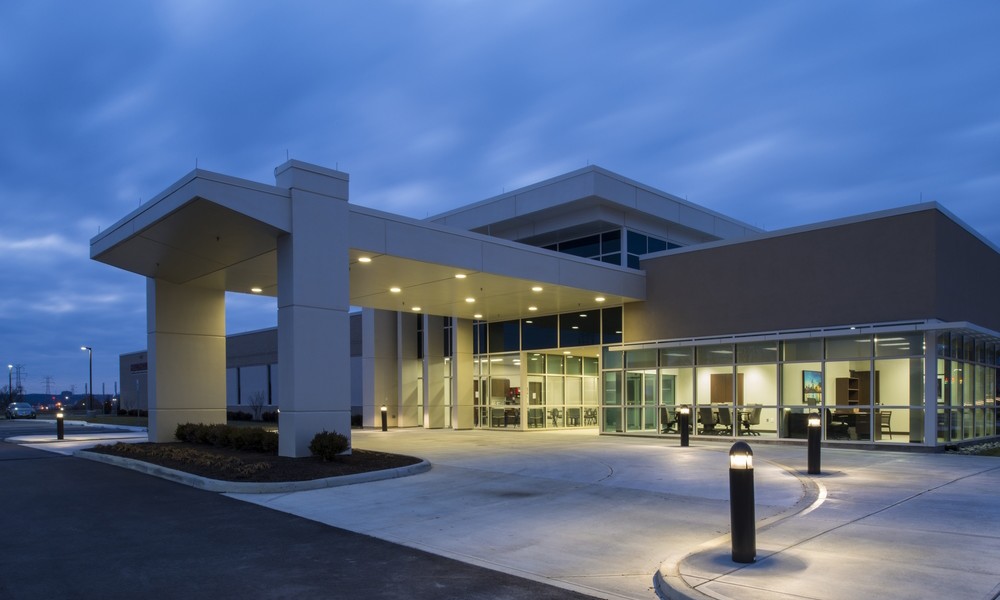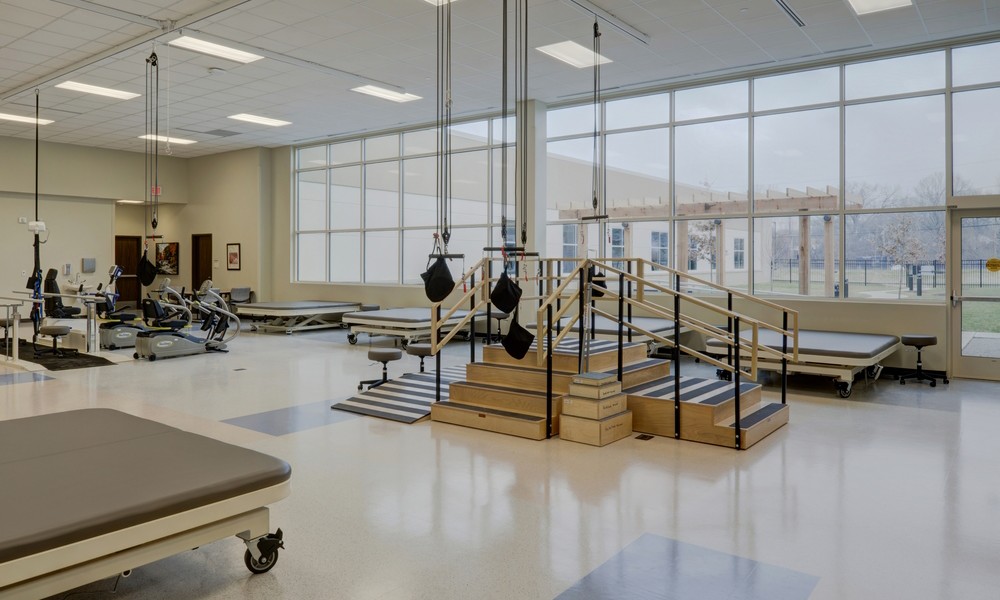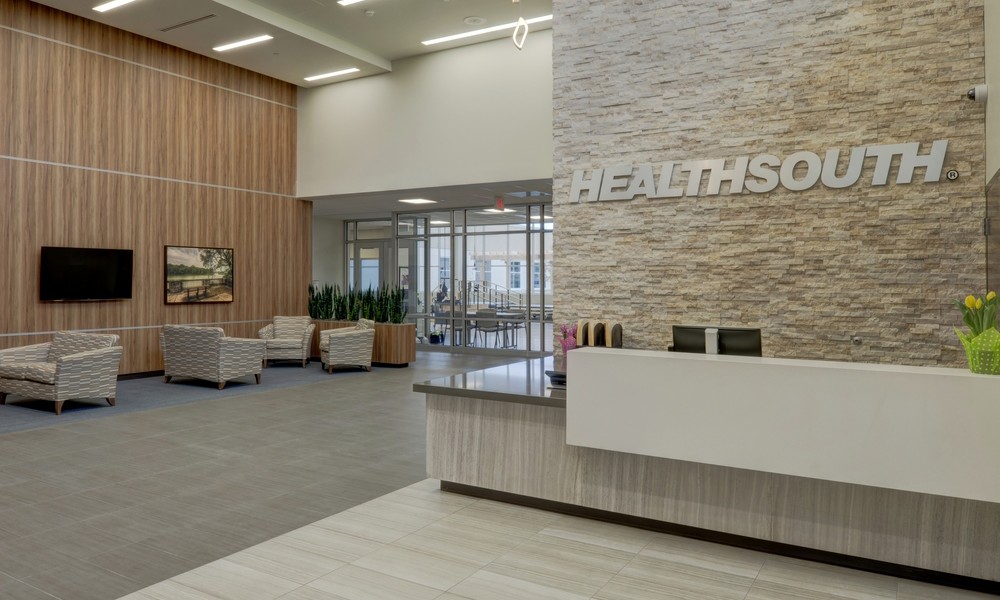Subscribe Now
Construction on $17M HealthSouth Inpatient Rehab Hospital Complete
BIRMINGHAM, Ala. – The Sanders Trust has recently completed the HealthSouth Rehabilitation Hospital of Cincinnati at Norwood. The 40-bed, $17-million inpatient rehabilitation hospital totals 50,000-square-feet and took 11 months for construction to be completed.Located in Cincinnati, Ohio, the hospital will provide physical, occupational and speech therapy services to patients recovering from stroke, trauma, brain and orthopedic injuries, as well as other major illnesses or injuries. Robins & Morton served as general contractor on the development, and Perkins+Will provided the architectural services.
The building is a single story, 44,000-square-foot inpatient rehabilitation hospital with 40 private patient rooms and designed to expand an additional 8 beds. The exterior façade is a combination of brick, exterior insulation and finish system with multiple finishes, and a curtainwall entrance system. The roof system is a white, single-ply, fully-adhered TPO membrane. The south elevation is highlighted with a large canopy. The canopy serves as a landmark for the main entry of the building, provides shade to the curtainwall system and weather protection for the building patrons.
The main entrance lobby has a 22-foot-high ceiling leading to the stone and quartz reception desk. The reception desk is highlighted with a stone veneer accent wall and cascading light fixture as a back drop. The ceiling height lowers to 17 feet at the waiting area to reduce the feel of the space to human scale. A simulated wood veneer panel access wall with complementary planters ties the lobby and waiting space all together with a warm, inviting atmosphere. Clear story windows allow natural sunlight into the lobby.
The therapy gym is in the center of the building and designed as the core of the rehabilitation process. To highlight the process, the perimeter of the gym is a storefront system, which allows visibility into the gym from the main entrance lobby and waiting area. The therapy gym has 14-foot ceiling heights and a full window wall along the exterior that lets in natural light and a direct view into the outdoor therapy courtyard. The volume of the room and additional sunlight provide a positive environment for the healing process of therapy. Overhead lifts are used at certain therapy equipment stations to assist in the therapy. An activities of daily living suite is included for home environment training.
The facility has two patient wings each with 20 private rooms. Each wing boasts a central nurse station located within the generous 23-foot-wide open area. This area serves as the patient corridor and activity space. The open concept allows patient interaction with each other, family and staff, as well as provides additional therapy space. Natural daylight is also incorporated into open area to continue the positive environment for healing.
The facility houses a full-service kitchen and dining room along with a 2,500-square-foot administrative suite.
Mechanical, electrical and plumbing systems were designed to meet stringent healthcare design requirements while working within a strict budget to produce highest value to the end user. The HVAC system is comprised of packaged rooftop air-handling units complying with code-required humidification, filtration, heating and cooling and medium pressure ductwork to terminal box distribution to provide a system with maximum patient controlability. The electrical system includes a 500KW generator with 4 automatic transfer switches serving life safety branch, critical power branch and two equipment branches. Two redundant, hot water boilers provide domestic hot water, 120 F to the building and 140 F to the kitchen. Medical gases include a vacuum pump and oxygen storage room distributing to patient care spaces with a zone for each patient wing with applicable area and master alarms.
Challenges
The site was a brownfield project and soil conditions were poor in certain portions. The project team was able to use an aggregate pier system, which helped start the project in winter conditions. Upon project commencement, the Norwood area was facing a historically bad winter and the project site ground was frozen. The team altered the originally planned sequencing of aggregate piers and concrete foundations to enable certain portions of the site to remain at existing grade elevations while the ground was frozen. In spite of the weather, major milestones were still met early in the project, and was completed in an 11-month build schedule.
When the project was 70 percent complete, the tenant, Reliant Healthcare, was acquired by HealthSouth. The new operator required different systems and equipment. All parties worked together to make sure these revisions were made with no change to project schedule and that the overall project budget was maintained.
Project Team
Developer: The Sanders Trust
Architect: Perkins + Will
MEP Engineers: ccrd
Structural: Bury + Partners
Civil Engineers: The Kleingers Group
Photos courtesy of The Sanders Trust.
Tags: Construction, Rehabilitation Hospital
Posted April 12, 2016
More Articles:
- Developments in BIM Virtual Symposium
Dec 3, 2024 – Dec 3, 2024 - Healthcare Environments 2024
Dec 8, 2024 – Dec 10, 2024 - IHI Forum
Dec 8, 2024 – Dec 11, 2024 - Construction SuperConference
Dec 9, 2024 – Dec 11, 2024 - 2024 New Orleans Cluster
Dec 9, 2024 – Dec 11, 2024 - EBD Journal Club: Blue Space: Extracting the Sensory Characteristics of Waterscapes as a Potential Tool for Anxiety Mitigation
Dec 17, 2024 – Dec 17, 2024















